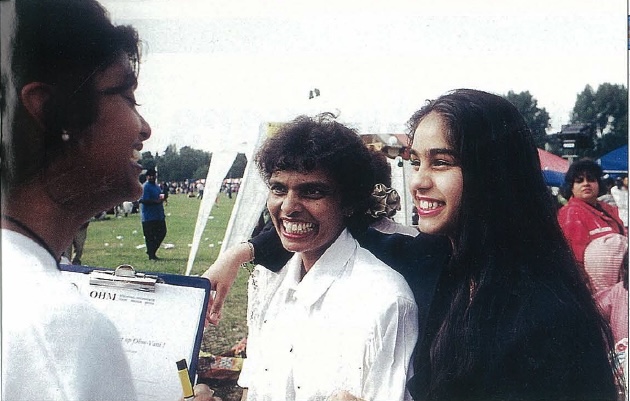Getting the stats: Dr. Chandersen Choenni prepared the survey and analyzed the results
Hundreds of thousands of Hindu children are growing up in societies far removed from that of their parents. Everyone knows they face unique challenges, and the national Hindu media network, OHM, set out to find out whether or not they were succeeding. They selected Dr. Chandersen Choenni, a well-known researcher on minority issues. He and OHM consultant Chander Mathura chose the 1998 three-day Milan cultural festival in The Hague, Holland, as the venue for the comprehensive youth survey. A group of ten Hindu volunteers, also youth, set out to interview 305 of their peers (defined as ages 12 to 29) during the festival. The results were tabulated and analyzed by the B & A group, then published, in Dutch, by OHM in November, 1998. There are more than 81,000 Hindus in Holland, with three to four thousand Hindus attending the Milan festival daily. Choenni acknowledges that neither the most conservative nor the most Westernized Hindus might attend the festival. Half of those interviewed were born in the Netherlands, the other half in Surinam.
The youth were not asked questions. Instead, they were presented with statements such as “Karma is how you act; not what you think” and asked whether they agreed with the statement, disagreed with it, or neither agreed nor disagreed. The community’s particular history played a major part in formulating some of the statements, as well as directing how they analyzed the results. Dutch Hindus are mostly from Surinam, in South America, where they lived for several generations after migrating from India in the 19th century. Just 15,000 are directly from India. Among the Surinam Hindus, most are traditionalists or Sanatanis, and a smaller percentage belong to the reformist Arya Samaj.
Dr. Choenni was surprised to find that “a large part of the respondents did not know which religious stream they belonged to or did not find that difference relevant.” Fifteen percent did not see themselves as part of either religious stream, and five percent refused to call themselves Hindu.
According the Dr. Choenni, the knowledge about Hinduism was rather poor and inconsistent. When read the correct statement that “Hinduism has no founder,” almost 60 percent agreed. Fifteen percent agreed with an incorrect statement which said “dharma is a havan which is done by the pundit”Ñindicating a lack of knowledge both of dharma and rituals. Even more dramatic was their lack of knowledge of scriptures. Just one fourth had heard of the Vedas, and only half knew of the Ramayana and Bhagavad Gita, both popular in Surinam.
When asked about the difficulty of living according to Hindu rules in the Netherlands, only 11.6 percent felt it was difficult. This was much more true for lower educated youth, with 23.2 percent having more difficulty than the higher educated, at only 7.4 percent. Most of those polled, 90.3 percent, said Hindus should be proud of their religion.
The youth’s view of parents was explored with the statement, “My parents think they know a lot about Hinduism”Ñ38.7 percent agreed. To a related statement, “According to me, my parents don’t know much about Hinduism,” 21.5 percent agreed.
Choenni summarizes his most important results in a table called “Cultural Orientation of Hindu Youngsters.” Only 15 percent agreed with: “I find it very important that my parents decide what’s best for me,” while a full two-thirds disagreed. Other statements show a similar departure from traditional values. Just ten percent agreed that “Hindu parents are capable of deciding on the best study for their child.” And a mere seven percent agreed that “Hindu parents are capable of deciding on the best marriage partner for their child.” Choenni was particularly surprised at this result, because “many parents still believe they are most capable of choosing the right partner for their child.” Twenty-four percent agreed that “Hindu youngsters should raise their child the way they were raised,” but the majority disagreed.
Other signs of cultural shift were revealed. A third could speak Hindi well, a third a bit and the rest not at all. Also, only a third of the youth prefer Indian movies to American movies, a dramatic shift from 20 years ago, according to Choenni, when most youth watched Indian movies.
For the full report visit:www.hinduismtoday.com/in-depth_issues/dutch_survey/
email:chan.choenni@minbzk.nl
